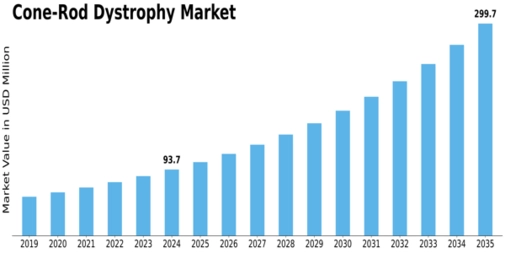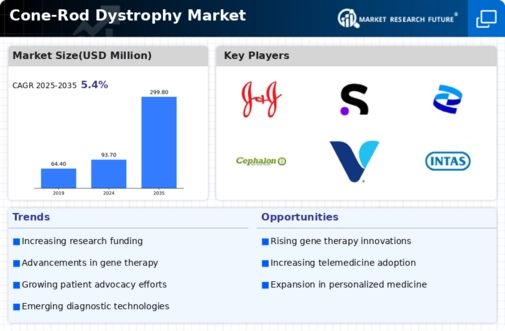-
Definition
-
Scope of the Study
- Research Objective
- Assumptions
- Limitations
-
Introduction
-
Primary Research
-
Secondary research
-
Market Size Estimation
-
Drivers
-
Restrains
-
Opportunities
-
Challenges
-
Macroeconomic Indicators
-
Technology Trends & Assessment
-
Porter’s Five Forces Analysis
- Bargaining Power of Suppliers
- Bargaining Power of Buyers
- Threat of New Entrants
- Threat of Substitutes
- Intensity of Rivalry
-
Value Chain Analysis
-
Investment Feasibility Analysis
-
Pricing Analysis
-
Chapter 6. Global Cone rod dystrophy Market, by Diagnosis
-
Introduction
-
Electroretinogram (ERG)
- Market Estimates & Forecast, 2023 – 2032
-
Clinical history
- Market Estimates & Forecast, 2023 – 2032
-
Fundus examination
- Market Estimates & Forecast, 2023 – 2032
-
Molecular diagnosis
- Market Estimates & Forecast, 2023 – 2032
-
Others
-
Chapter 7. Global Cone rod dystrophy Market, by Treatment
-
Introduction
-
Tinted lenses/ dark sunglass
- Market Estimates & Forecast, 2023 – 2032
-
Medications
- Market Estimates & Forecast, 2023 – 2032
- Vitamin A supplement
- Anticonvulsant
-
Magnifying devices
- Market Estimates & Forecast, 2023 – 2032
-
Surgery
- Market Estimates & Forecast, 2023 – 2032
-
Chapter 8. Global Cone rod dystrophy Market, by End User
-
Introduction
-
Hospitals
- Market Estimates & Forecast, 2023 – 2032
-
Ophthalmic centers
- Market Estimates & Forecast, 2023 – 2032
-
Research organizations
- Market Estimates & Forecast, 2023 – 2032
-
Academic institutes
- Market Estimates & Forecast, 2023 – 2032
-
Chapter. 9 Global Cone rod dystrophy Market, by Region
-
Introduction
-
Americas
- North America
- South America
-
Europe
- Western Europe
- Eastern Europe
-
Asia Pacific
- Japan
- China
- India
- Australia
- Republic of Korea
- Rest of Asia Pacific
-
The Middle East & Africa
- United Arab Emirates
- Saudi Arabia
- Rest of the Middle East & Africa
-
Chapter 10 Company Landscape
-
Introduction
-
Market Share Analysis
-
Key Development & Strategies
- Key Developments
-
Chapter 11 Company Profiles
-
GlaxoSmithKline Plc
- Company Overview
- Treatment Overview
- Financials
- SWOT Analysis
-
Johnson & Johnson
- Company Overview
- Treatment Overview
- Financial Overview
- Key Developments
- SWOT Analysis
-
Sanofi
- Company Overview
- Treatment Overview
- Financial Overview
- Key Development
- SWOT Analysis
-
Pfizer Inc.
- Company Overview
- Treatment/Business Segment Overview
- Financial Overview
- Key Development
- SWOT Analysis
-
Novartis AG
- Company Overview
- Treatment Overview
- Financial overview
- Key Developments
-
Abbott Laboratories
- Company Overview
- Treatment Overview
- Financial Overview
- Key Developments
-
Sunovion Pharmaceuticals
- Overview
- Treatment Overview
- Financials
- Key Developments
- SWOT Analysis
-
Cephalon
- Company Overview
- Treatment/Business Segment Overview
- Financial Overview
- Key Development
- SWOT Analysis
-
DSM
- Company Overview
- Treatment Overview
- Financial overview
- Key Developments
-
Vitamin Shoppe
- Company Overview
- Treatment/Business Segment Overview
- Financial Overview
- Key Development
- SWOT Analysis
-
Intas Pharmaceutials Limited
- Company Overview
- Treatment Overview
- Financial overview
- Key Developments
-
Sun Pharmaceuticals Ltd.
- Company Overview
- Treatment/Business Segment Overview
- Financial Overview
- Key Development
- SWOT Analysis
-
Emcure Pharmaceuticals Limited
- Company Overview
- Treatment Overview
- Financial overview
- Key Developments
-
Nutrilite
- Company Overview
- Treatment/Business Segment Overview
- Financial Overview
- Key Development
- SWOT Analysis
-
NutraScience Labs
- Company Overview
- Treatment Overview
- Financial overview
- Key Developments
-
Others
-
Chapter 12 MRFR Conclusion
-
Key Findings
- From CEO’s View Point
- Unmet Needs of the Market
-
Key Companies to Watch
-
Prediction of Pharmaceutical industry
-
Chapter 13 Appendix
-
LIST OF TABLES
-
Cone rod dystrophy Industry Synopsis, 2023 – 2032
-
Cone rod dystrophy Market Estimates and Forecast, 2023 – 2032, (USD Million)
-
Cone rod dystrophy Market by Region, 2023 – 2032, (USD Million)
-
Cone rod dystrophy Market by Diagnosis, 2023 – 2032, (USD Million)
-
Cone rod dystrophy Market by Treatment, 2023 – 2032, (USD Million)
-
Cone rod dystrophy Market by End Users, 2023 – 2032, (USD Million)
-
North America Cone rod dystrophy Market by Diagnosis, 2023 – 2032, (USD Million)
-
North America Cone rod dystrophy Market by Treatment, 2023 – 2032, (USD Million)
-
North America Cone rod dystrophy Market by End User, 2023 – 2032, (USD Million)
-
US Cone rod dystrophy Market by Diagnosis, 2023 – 2032, (USD Million)
-
US Cone rod dystrophy Market by Treatment, 2023 – 2032, (USD Million)
-
US Cone rod dystrophy Market by End User, 2023 – 2032, (USD Million)
-
Canada Cone rod dystrophy Market by Diagnosis, 2023 – 2032, (USD Million)
-
Canada Cone rod dystrophy Market by Treatment, 2023 – 2032, (USD Million)
-
Canada Cone rod dystrophy Market by End User, 2023 – 2032, (USD Million)
-
South America Cone rod dystrophy Market by Diagnosis, 2023 – 2032, (USD Million)
-
South America Cone rod dystrophy Market by Treatment, 2023 – 2032, (USD Million)
-
South America Cone rod dystrophy Market by End User, 2023 – 2032, (USD Million)
-
Europe Cone rod dystrophy Market by Diagnosis, 2023 – 2032, (USD Million)
-
Europe Cone rod dystrophy Market by Treatment, 2023 – 2032, (USD Million)
-
Europe Cone rod dystrophy Market by End User, 2023 – 2032, (USD Million)
-
Western Europe Cone rod dystrophy Market by Diagnosis, 2023 – 2032, (USD Million)
-
Western Europe Cone rod dystrophy Market by Treatment, 2023 – 2032, (USD Million)
-
Western Europe Cone rod dystrophy Market by End User, 2023 – 2032, (USD Million)
-
Eastern Europe Cone rod dystrophy Market by Diagnosis, 2023 – 2032, (USD Million)
-
Eastern Europe Cone rod dystrophy Market by Treatment, 2023 – 2032, (USD Million)
-
Eastern Europe Cone rod dystrophy Market by End User, 2023 – 2032, (USD Million)
-
Asia Pacific Cone rod dystrophy Market by Diagnosis, 2023 – 2032, (USD Million)
-
Asia Pacific Cone rod dystrophy Market by Treatment, 2023 – 2032, (USD Million)
-
Asia Pacific Cone rod dystrophy Market by End User, 2023 – 2032, (USD Million)
-
The Middle East & Africa Cone rod dystrophy Market by Diagnosis, 2023 – 2032, (USD Million)
-
The Middle East & Africa Cone rod dystrophy Market by Treatment, 2023 – 2032, (USD Million)
-
The Middle East & Africa Cone rod dystrophy Market by End User, 2023 – 2032, (USD Million)
-
LIST OF FIGURES
-
Research Process
-
Segmentation for Cone rod dystrophy Market
-
Segmentation Market Dynamics for Cone rod dystrophy Market
-
Global Cone rod dystrophy Market Share, by Diagnosis 2023
-
Global Cone rod dystrophy Market Share, by Treatment 2023
-
Global Cone rod dystrophy Market Share, by End Users, 2023
-
Global Cone rod dystrophy Market Share, by Region, 2023
-
North America Cone rod dystrophy Market Share, by Country, 2023
-
Europe Cone rod dystrophy Market Share, by Country, 2023
-
Asia Pacific Cone rod dystrophy Market Share, by Country, 2023
-
The Middle East & Africa Cone rod dystrophy Market Share, by Country, 2023
-
Global Cone rod dystrophy Market: Company Share Analysis, 2023 (%)
-
GlaxoSmithKline Plc: Key Financials
-
GlaxoSmithKline Plc: Segmental Revenue
-
GlaxoSmithKline Plc: Geographical Revenue
-
Johnson & Johnson: Key Financials
-
Johnson & Johnson: Segmental Revenue
-
Johnson & Johnson: Geographical Revenue
-
Sanofi: Key Financials
-
Sanofi: Segmental Revenue
-
Sanofi: Geographical Revenue
-
Pfizer Inc.: Key Financials
-
Pfizer Inc.: Segmental Revenue
-
Pfizer Inc.: Geographical Revenue
-
Novartis AG: Key Financials
-
Novartis AG: Segmental Revenue
-
Novartis AG: Geographical Revenue
-
Abbott Laboratories: Key Financials
-
Abbott Laboratories: Segmental Revenue
-
Abbott Laboratories: Geographical Revenue
-
Sunovion Pharmaceuticals: Key Financials
-
Sunovion Pharmaceuticals: Segmental Revenue
-
Sunovion Pharmaceuticals: Geographical Revenue
-
Cephalon: Key Financials
-
Cephalon: Segmental Revenue
-
Cephalon: Geographical Revenue
-
DSM: Key Financials
-
DSM: Segmental Revenue
-
DSM: Geographical Revenue
-
Amway: Key Financials
-
Amway: Segmental Revenue
-
Amway: Geographical Revenue
-
Vitamin Shoppe: Key Financials
-
Vitamin Shoppe: Segmental Revenue
-
Vitamin Shoppe: Geographical Revenue
-
Intas Pharmaceutials Limited: Key Financials
-
Intas Pharmaceutials Limited: Segmental Revenue
-
Intas Pharmaceutials Limited: Geographical Revenue
-
Sun Pharmaceuticals Ltd: Key Financials
-
Sun Pharmaceuticals Ltd: Segmental Revenue
-
Sun Pharmaceuticals Ltd: Geographical Revenue
-
Emcure Pharmaceuticals Limited: Key Financials
-
Emcure Pharmaceuticals Limited: Segmental Revenue
-
Emcure Pharmaceuticals Limited: Geographical Revenue
-
Nutrilite: Key Financials
-
Nutrilite: Segmental Revenue
-
Nutrilite: Geographical Revenue
-
NutraScience Labs: Key Financials
-
NutraScience Labs: Segmental Revenue
-
NutraScience Labs: Geographical Revenue





















Leave a Comment